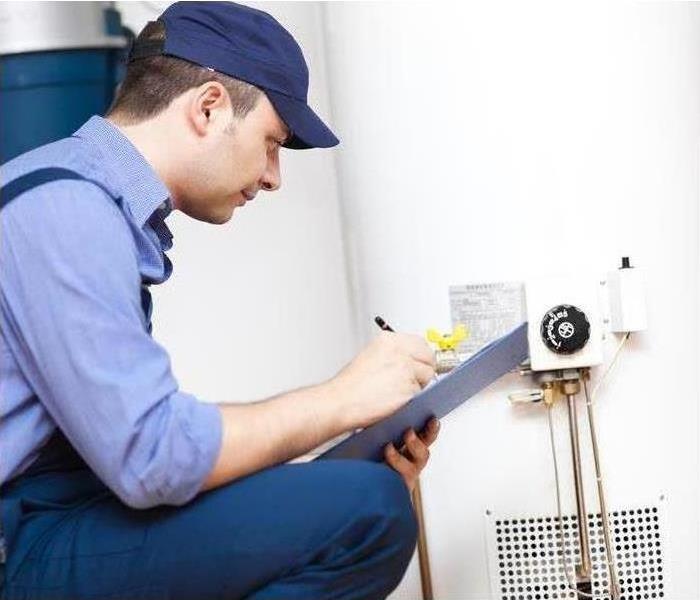Preventing Mold Begins With You
4/25/2024 (Permalink)
 Do not clean or apply biocides to visible mold on porous surfaces - call SERVPRO to safely take care of mold remediation.
Do not clean or apply biocides to visible mold on porous surfaces - call SERVPRO to safely take care of mold remediation.
To minimize the potential for mold growth in your building, you must:
• Keep your building clean—particularly the kitchen, the bathrooms, carpets, and floors. Regular vacuuming and mopping, plus cleaning hard surfaces using a household cleaner, are all important to remove the dirt and debris that harbor mold or food for mold. Throw away moldy food immediately.
• Remove visible moisture accumulations on windows, walls, ceilings, floors, and other surfaces as soon as reasonably possible. Look for leaks in washing machine hoses and discharge lines, especially if the leak is large enough for water to seep into nearby walls. If your property has them, turn on exhaust fans in the bathroom before showering and in the kitchen before cooking with open pots. Also when showering, keep the shower curtain inside the tub (or fully close the shower doors). Experts also recommend that after a shower or bath, you (1) wipe the moisture off shower walls, shower doors, the bathtub, and the bathroom floor; (2) leave the bathroom door open until all moisture on the mirrors and bathroom walls and tile surfaces has dissipated; and (3) hang up your towels and bath mats so they will completely dry out.
• Notify your service provider about any air-conditioning or heating-system problems you discover. Make sure to replace the air filters. It’s good practice to open windows and doors periodically on days when the outdoor weather is dry (i.e., humidity is below 50%) to help humid areas of your building dry out.
• Promptly notify SERVPRO® of any signs of water leaks, water infiltration, or mold. We will respond within the same day.
Avoiding Moisture Buildup
To avoid mold growth, it’s important to prevent excess moisture buildup in your building. Failing to promptly attend to leaks and moisture accumulations on property surfaces can encourage mold growth, especially in places where they might get inside walls or ceilings. Prolonged moisture can come from a wide variety of sources, such as:
• rainwater leaking from roofs, windows, doors, and outside walls, as well as flood waters rising above floor level;
• overflows from showers, bathtubs, toilets, sinks, washing machines, dehumidifiers, refrigerator or air-conditioner drip pans, or clogged air-conditioner condensation lines;
• leaks from plumbing lines or fixtures, and leaks into walls from bad or missing grouting or caulking around showers, bathtubs, or sinks;
• washing machine hose leaks, plant-watering overflows, pet urine, cooking spills, beverage spills, and steam from excessive open-pot cooking;
• leaks from clothes-dryer discharge vents (which can put a lot of moisture into the air); and
• insufficient drying of carpets, carpet pads, shower walls, and bathroom floors.
Cleaning Mold
If small areas of mold have already accumulated on nonporous surfaces (such as ceramic tile, Formica, vinyl flooring, metal, wood, or plastic), the Environmental Protection Agency recommends that you first clean the areas with soap (or detergent) and water and let the surface dry thoroughly. (Applying biocides without first cleaning away the dirt and oils from the surface is like painting over old paint without first cleaning and preparing the surface.) When the surface is dry—and within 24 hours of cleaning—apply a premixed spray-on household biocide such as Lysol Disinfectant, Original Pine-Sol Cleaner, Tilex Mold & Mildew Remover or Clorox Clean-up Cleaner + Bleach. (Note two things: First, only a few of the common household cleaners can actually kill mold. Second, Tilex and Clorox contain bleach, which can discolor or stain surfaces, so follow the instructions on the container.) Always clean and apply a biocide to an area five or six times larger than any mold you see—mold can be present but not yet visible to the naked eye. A vacuum cleaner with a high-efficiency particulate air (HEPA) filter can be used to help remove non-visible mold products from porous items such as fibers in sofas, chairs, drapes, and carpets—provided the fibers are completely dry. Machine washing or dry cleaning will remove mold from clothes.
Warning for Porous Surfaces and Large Surfaces
Do not clean or apply biocides to visible mold on porous surfaces such as sheetrock walls or ceilings or too large areas of visible mold on nonporous surfaces. Instead, notify SERVPRO.
Call 775-588-2355 and we will come to your location quickly to assess the damage. Our trained technicians will make sure your property is safe and professionally cleaned.






 24/7 Emergency Service
24/7 Emergency Service